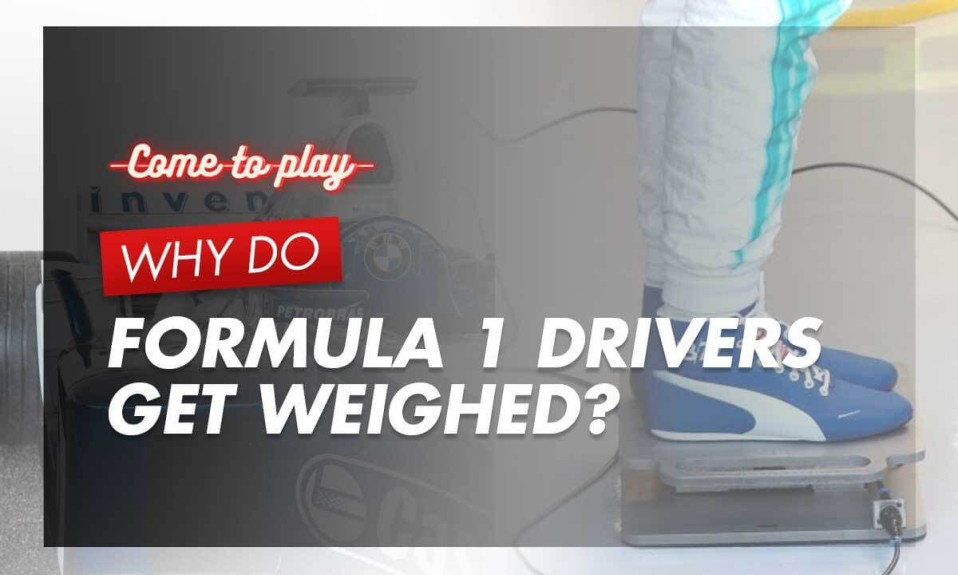Have you ever wondered: “Why do F1 drivers get weighed” immediately after a race, and shouldn’t they join the post-race celebrations instead of queuing in front of scales?
Well, weighing is obligatory for two reasons: to check how much weight drivers lost during the race and to ensure they and their cars are above the stipulated minimum weight.
We thoroughly explore both reasons below!
Why Do Formula 1 Drivers Get Weighed?

First, we’ll look at the medical reasoning for weighing drivers before going over the anti-cheating regulations that mandate teams meet a combined minimum weight requirement.
1. Medical Reason
The first reason why the weight of F1 drivers must be recorded after the race is medical in nature, as every interested party, including racers, teams, and the FIA, need to understand the rate at which weight is shed via sweating during any two-hour-long F1 race.
Since the FIA is concerned with driver safety, they need to know whether or not certain races are too taxing, which may ultimately lead to dehydration and heat exhaustion, so they can properly improve the track and racing conditions for future events.
For example, when racing on hotter and physically demanding tracks, especially during the summer, drivers lose up to 4 kg via sweat during a race, even without peeing.
On the other hand, the teams and racers must know the actual weight lost during the races, so they adjust the upcoming training schedule accordingly to recover that mass.
Note: Drivers are weighed before they can eat or drink anything with all their equipment, including suits, gloves, helmets, and the HANS device, to establish their ‘seat weight’.
You might also be interested in: What is DRS in F1?
2. Technical Reason
The second, more important reason why the F1 driver weight is checked is to ensure that teams comply with the annual rules regarding the minimum combined weight of the F1 car and driver, which were implemented to facilitate fair racing as weight is a major factor in speed.
As of the 2022 F1 season, the minimum limit set forth by FIA requires a combined weight of 798 kg (an increase of 46 kg since the year before) without the fuel weight.
Moreover, at least 80 kg of the total weight must come from the ‘seat weight’ (explained above), so ballast weights are added if the driver is lighter than the minimum.
Before the introduction of these rules in 2019, F1 teams hired lighter racers who had to lose an unhealthy amount of weight to gain an advantage over other cars, at an increased risk of accidents or even death as they lacked the focus and muscle strength to control an F1 car.
Does Weight Matter in F1?

Any basic equation that includes speed and mass tells us that if the car’s horsepower remains the same, you can increase your speed if you reduce the mass.
Therefore, weight is critical in F1 since the heavier the car and the driver, the engine has to work that much harder to move them around, and we all know that literal fractions of a second can be the difference between winning or losing the race.
Despite being the fastest racing machines in the world, F1 cars can go about 0.3 seconds per lap faster with every 10 kg they lose—a massive difference in qualifying and the race.
No wonder, then, that we hear anecdotal stories of F1 champions going the extra mile to lose any excess weight to improve their lap times, such as one of the greatest F1 drivers, Michael Schumacher choosing to apply lighter paint to his helmet and Nico Rosberg avoiding cycling to lose leg muscle weight.
Related: How much do F1 drivers make?
How Much Do F1 Drivers Weigh?

Despite the recent weight restrictions, smaller individuals still have an advantage due to their lower centre of gravity, which is why ballasts are mounted as low as possible.
Having said that, let’s look at the driver weight distribution of the 2022 F1 grid:
| Driver | Weight | Height | Team |
| Yuki Tsunoda | 54 kg | 1.59 m | AlphaTauri |
| Sebastian Vettel | 62 kg | 1.75 m | Aston Martin |
| Sergio Perez | 63 kg | 1.73 m | Red Bull |
| Zhou Guanyu | 63 kg | 1.75 m | Alfa Romeo |
| Carlos Sainz | 64 kg | 1.78 m | Ferrari |
| Daniel Ricciardo | 66 kg | 1.80 m | McLaren |
| Esteban Ocon | 66 kg | 1.86 m | Alpine |
| Mick Schumacher | 67 kg | 1.76 m | Haas |
| Lando Norris | 68 kg | 1.70 m | McLaren |
| Fernando Alonso | 68 kg | 1.71 m | Alpine |
| Kevin Magnussen | 68 kg | 1.74 m | Haas |
| Valtteri Bottas | 69 kg | 1.73 m | Alfa Romeo |
| Charles Leclerc | 69 kg | 1.80 m | Ferrari |
| Pierre Gasly | 70 kg | 1.77 m | AlphaTauri |
| Lance Stroll | 70 kg | 1.82 m | Aston Martin |
| George Russell | 70 kg | 1.85 m | Mercedes |
| Max Verstappen | 72 kg | 1.81 m | Red Bull |
| Lewis Hamilton | 73 kg | 1.74 m | Mercedes |
| Nicholas Latifi | 73 kg | 1.85 m | Williams |
| Alex Albon | 74 kg | 1.86 m | Williams |
As you can see, the heaviest F1 driver is Albon at 74 kg and 1.86 m, the lightest is Tsunoda with 54 kg and 1.59 m, and the average weight of Formula 1 drivers is about 68 kg.
Thankfully, F1 introduced the minimum driver weight limit rule, as without it, the racers at the top of this table would have had an unfair advantage over those below.
Bottom Line
Now that you understand why do F1 drivers get weighed, you should have a better appreciation for the measures employed by teams, racers, and the FIA to ensure a level racing field without sacrificing performance or driver safety.

